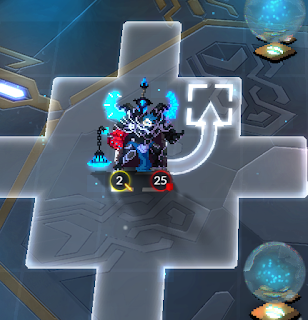Let me preface this by saying that my deepest card game experience comes from Magic. Magic does not have a tactical board. When I was first playing Duelyst, this had a big influence on my thought pattern; it was hard for me to wrap my head around the significance of where you drop units down. If the units can move in any direction, and they can all move the same two tiles, what does it really matter where you put them? Nothing changes until the units get next to each other and fight anyway.
That may sound reductionist, but that was my initial impression. Whenever I lost a game, I felt it was not due to where I placed my units, but WHAT I and my opponent placed; in other words, I would lose because my opponent played something that I didn't have the cards to deal with at that moment. Card quality seemed to trump positioning.
Playing through all the single-player challenges, I could see how placement mattered when going for a killing blow, or in getting Provoke minions out of the way. But, playing around a static opponent over a single turn, I still didn't really get one of the most important aspects of positioning -- limiting your opponent's choices.
Most units can't act when you play them. One of the biggest swings in control of a match is being able to take out a dangerous minion right away, before it has a chance to do anything. If you can protect your units with good placement, however, you can make it harder to do that.
So here's how I would have explained it to myself when I started playing...
Basic Movement and the Diagonal
In Duelyst, every unit and general can move 2 squares. However, units cannot move directly on the diagonally: it takes them two steps to move to a diagonal space. Look at the arrow here to see what I mean:
See the *bend* in the arrow? That's a right-up move, not a direct diagonal crossing! Don't believe the animations; it's all an illusion designed to shield you from the horror of a world without diagonal movement. (The arrow bend is especially pronounced with flying units.)
This also explains the technical details of why can't you move between two enemies staggered diagonally: you can't move through enemies, and you would need to in order to get to that corner space. See the white movement options highlighted here:
Now, although you can't move directly to a diagonal space, you *can* ATTACK directly on the diagonal, you can PLACE UNITS on the diagonal, and you can use abilities that say NEARBY such as Ephemeral Shroud or Entropic Decay on the diagonal. The above general, blocked from moving north-west, could still attack a minion stationed there, or place a minion there.
This mismatch is important. It means that taking the above actions on the diagonal allows you to "skip" a move. So, when you block the diagonal, you are stealing not one, but two movement from the enemy, as opposed to blocking laterally or vertically.
Take the following two placements. This one looks protective, but if you end your turn like this, the general can step to the side and attack:
This position, however, prevents the general from reaching your unit directly, using a diagonal block:
All tiles are equally distant for attacks and unit placement, but diagonal movement is more expensive, which makes diagonal tiles more "distant". If you can inhibit the enemy's movement on that axis, you can make it much harder to reach something they want to reach, whether that is a unit, your general, or a mana spring tile. This gives some more context for thinking about "reach" and thinking beyond just anticipating movement.
Reach and Anticipation
I think of "reach" as the distance at which your enemy could accomplish certain placements or attacks based on the board state when you end your turn. For example, if we place our fancy, shiny, dangerous unit thusly, and end our turn:
It is safe from general attacks, true -- but not from a single "Ephemeral Shroud" placement, which dispels a NEARBY minion.
From here, none of their options for placing one Ephemeral Shroud will reach your unit!
This assumes your opponent doesn't have multiple units to throw down, but even in those cases, anything that limits their options and forces them to play a specific combination of cards will on average be to your advantage.
This is just one way you can think about "reach" and how to position units outside the reach of certain threats you know your opponent might be playing -- or, conversely, how to position your general out of reach of potential threats. The more meta-knowledge you can gather about likely cards to be played, the smarter you can be when placing both units and your general defensively.
Yes, Sometimes it Doesn't Matter
It's true that there are many, many cards that bypass the whole positioning thing, such as targeted spells, or flying units. Still, even if you will often encounter situations where your careful placement is meaningless based on the cards played against you, don't let that discourage you from trying to make better positioning decisions. Well placed units can cut off your opponent's choices and make them spend unnecessary resources. Poorly placed units give your opponent more options to make favorable moves and choose the least costly card to deal with your threat. Every once in a while, that one positional choice will mean the difference between winning and losing.
So respect the diagonal when you place your next unit. And leave comments if you found this useful, or have more to add.










